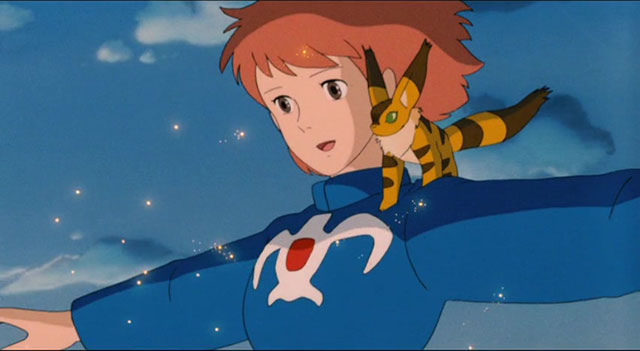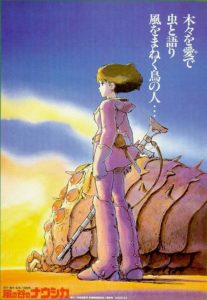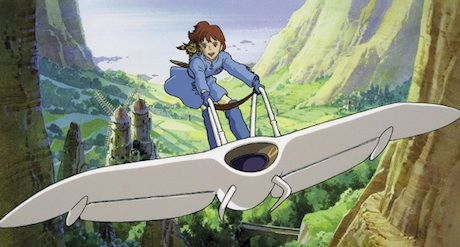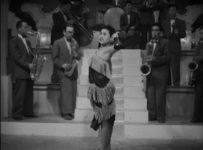Welcome back to 80s Bits, the weekly column in which we explore the best and worst of the Decade of Shame. With guest writers, hidden gems and more, it’s truly, truly, truly outrageous.
[stextbox id=”grey” caption=”Nausicaä of the Valley of the Wind (1984)” float=”true” align=”right” width=”200″]
Director: Hayao Miyazaki
Writers(s): Hayao Miyazaki
Runtime: 116 minutes
Starring: Sumi Shimamoto, Mahito Tsujimura, Hisako Kyôda, Gorô Naya
Distributor: Toei Company
Country: Japan
Rating: Certified Bitstastic (★★★★★) (?)
[/stextbox]
In the heart of the beautiful Inokashira Park, in the western Tokyo city called Mitaka, stands a giant robot. Around this robot is a museum, but not just any museum. Officially opened in 2001, the Ghibli Museum is a place with no set path to follow, and no particular way of exploring the treasures within. It is a celebration of the magical exploration of childhood and nature that can be found in every Ghibli film.
With recent global hits such as Ponyo and the Academy Award-winning Spirited Away, Japanese godfather of animation Hayao Miyazaki and his Studio Ghibli have well and truly established themselves as makers of globally beloved films. The studio has produced such wonderful gems as My Neighbour Totoro and Princess Mononoke, yet it is arguable that Nausicaä of the Valley of the Wind is the film that started it all. While it is not the first film that Miyazaki directed, with that honour going to the Lupin III film The Castle of Cagliostro, Nausicaä of the Valley of the Wind is seen by many as the film that launched Studio Ghibli.
A thousand years after the “Seven Days of Fire” destroyed much of the Earth’s ecosystem, there are only isolated pockets of humanity alive, separated by the giant pollution-induced Sea of Corruption inhabited by giant insects, not least of which is the formidable crustacean-like Ohmu. One such pocket colony is the agrarian Valley of the Wind, and its princess Nausicaä has a peculiar ability to talk to the insects and other creatures that roam the land.
When an airship crash-lands near the Valley, Nausicaä tries to rescue a girl from the crash. Unable to save her, the girl reveals that she is the Princess Lastelle from the kingdom Pejite, and they should burn the cargo of the ship. It is later revealed that the cargo is the embryo of a giant God Warrior, one of the instruments of destruction in the earlier catastrophic wars that destroyed the environment. This chain of events brings with it the Tolmekians, who attempt to dominate the landscape and destroy the deadly spores in the toxic jungle surrounds, although this too may have disastrous consequences on the environment and their very lives. It is up to Nausicaä to prevent this from occurring, but will even she be able to stand against the unstoppable force of nature?
In 1982, Miyazaki began serialising the manga of Nausicaä of the Valley of the Wind in Animage, a magazine he worked on for some years. After the success of The Castle of Cagliostro, in which Miyazaki acted as a director for hire on someone else’s production, he was inspired to adapt his own serialised manga (which continued to run until 1994) to the screen. Drawing inspiration from works as diverse as Dune, Journey to the Centre of the Earth and even Bedknobs and Broomsticks (according to some sources), Miyazaki creates a world that is entirely his own. Although certainly not completed at the time the film was produced, Miyazaki would spent 12 years completing his 7 volume/1100+ page masterwork between other Ghibli movies, such as Kiki’s Delivery Service and Porco Rosso.
It is clearly a labour of love for the master, and a world that Miyazaki is intimately familiar with. One gets the feeling that Miyazaki would know the background of every minor and peripheral character inhabiting the Valley, even those seen in passing. As a result, this remains one of his most personal works and on some levels his most accomplished. While the quality of animation and the tightness of the storytelling may have improved over the years, Nausicaä of the Valley of the Wind remains a landmark achievement for both Studio Ghibli and Japanese animation generally.
As with a number of other Miyazaki films, Nausicaä of the Valley of the Wind is principally concerned with the environment, and the impact of humankind’s intervention on it. The aforementioned Princess Mononoke, along with Laputa: Castle in the Sky and Ponyo, all with a threatened ecosystem and the encroaching dangers of humankind’s involvement and the self-destructive nature of humans. The major irony at the heart of the story is that the humans are destroying the very thing that is attempting to heal the planet, and the human story is just as fascinating.
Unlike many of Miyazaki’s other films that deal with the subject, where the fantasy elements are skewed more towards a younger audience, the epic and often dark nature of Nausicaä of the Valley of the Wind is aimed at the adults as well. After all, they are the ones that have the power to cause and/or save the planet in question. However, unlike the more heavy-handed Ponyo, the deeper environmental issues are used as an underlying motivational aspect to the storyline, rather than the obvious moral tale that would be found in Miyazaki’s later works.
Visually, the film is a triumph in modern animation. Using a combination of traditional hand-painted animation, and even paper-cut segments on the Ohmu animation, Miyazaki draws from a variety of excellent visual storytellers for inspiration. The works of French artist Moebius can be seen in the machinery and the aircraft in particular (Miyazaki is a renowned plane fanatic, as evidenced by flying ace Porco Rosso), and his own comic-book influences from the previous Lupin works and classic archetype characters are prominent. Hideaki Anno, who would later go on to great acclaim with his Evangelion series and films, shows his early natural talents during the attack of the God Warrior sequence, along with hinting at some of the influences that would lead him to a career of angel and demon clashes.
The influence of Nausicaä of the Valley of the Wind is incalculable. Noted anime historian and commentator Helen McCarthy, writing with Jonathan Clements, points out that several films that had no relation to Nausicaä of the Valley of the Wind actually changed their original titles to things like Wind of Amnesia and Wings of Honneamise to reflect the trends that emerged from the film. Regardless, Nausicaä of the Valley of the Wind remains one of the most beloved animated films of all time both inside and outside of Japan, thanks to a winning combination of groundbreaking animation and a central message that is still highly pertinent over a quarter of a century later.








Great review! Nausicaa is still my favourite Miyazaki Production, the Manga is also very good. Some say better, which is difficult to believe.
One of these days, I will get around to reading that manga. If only I knew somebody with a copy… 🙂
+1 for the manga being better than the film. I is a while since I read it, but it is a much longer. There too much going on in the manga for one movie and as a result some major changes are made to the story. The movie is edited down very skilfully, but is in many ways it is a different tale.